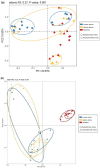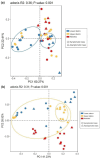Microbial communities in the phyllosphere and endosphere of Norway spruce under attack by Heterobasidion
- PMID: 39845034
- PMCID: PMC11750781
- DOI: 10.3389/fmicb.2024.1489900
Microbial communities in the phyllosphere and endosphere of Norway spruce under attack by Heterobasidion
Abstract
Heterobasidion annosum species complex has been regarded as the most destructive disease agent of conifer trees in boreal forests. Tree microbiome can regulate the plant-pathogen interactions by influencing both host resistance and pathogen virulence. Such information would help to improve the future health of forests and explore strategies to enhance ecosystem stability. In this study, using next-generation sequencing technology, we investigated the microbial community in different tree regions (needles, upper stem, and lower stem) of Norway spruce with and without wood decay symptoms. The primary purpose was to uncover signature characteristic microbiome harbored by asymptomatic trees compared to diseased trees. Additionally, the study was to explore the inter-kingdom and intra-kingdom interactions in microbiome (bacteria and fungi) of symptomatic versus asymptomatic trees. The results showed that in upper stem, species richness (Chao1) of fungi and bacteria were both higher in asymptomatic trees than symptomatic trees (P < 0.05). Compared to symptomatic trees, asymptomatic trees harbored a higher abundance of Actinobacteriota, bacterial genera of Methylocella, Conexibacter, Jatrophihabitans, and fungal genera of Mollisia. Fungal communities from the same anatomic region differed between the symptomatic and asymptomatic trees. Bacterial communities from the two stem regions were also distinct between the symptomatic and asymptomatic trees. The symptomatic trees possessed a less stable microbial network with more positive correlations compared to the asymptomatic trees. In the lower stem, at intra-kingdom level, the distribution of correlation numbers was more even in the bacterial network compared to the fungal network. In conclusion, the Heterobasidion attack decreased the microbial community species richness and shifted the community structure and functional structure to varying degrees. The microbial network was enlarged and became more unstable at both inter-kingdom and intra-kingdom level due to the Heterobasidion infection.
Keywords: Heterobasidion; microbial community diversity; microbial community structure; microbial interaction; network analysis.
Copyright © 2025 Meng, Wen, Kasanen, Sun and Asiegbu.
Conflict of interest statement
The authors declare that the research was conducted in the absence of any commercial or financial relationships that could be construed as a potential conflict of interest.
Figures








Similar articles
-
Tissue Microbiome of Norway Spruce Affected by Heterobasidion-Induced Wood Decay.Microb Ecol. 2019 Apr;77(3):640-650. doi: 10.1007/s00248-018-1240-y. Epub 2018 Aug 9. Microb Ecol. 2019. PMID: 30094615
-
Mycobiome analysis of asymptomatic and symptomatic Norway spruce trees naturally infected by the conifer pathogens Heterobasidion spp.Environ Microbiol Rep. 2018 Oct;10(5):532-541. doi: 10.1111/1758-2229.12654. Epub 2018 Sep 3. Environ Microbiol Rep. 2018. PMID: 29727054
-
Dual RNA-seq analysis provides new insights into interactions between Norway spruce and necrotrophic pathogen Heterobasidion annosum s.l.BMC Plant Biol. 2019 Jan 3;19(1):2. doi: 10.1186/s12870-018-1602-0. BMC Plant Biol. 2019. PMID: 30606115 Free PMC article.
-
Heterobasidion Partitivirus 13 Mediates Severe Growth Debilitation and Major Alterations in the Gene Expression of a Fungal Forest Pathogen.J Virol. 2018 Feb 12;92(5):e01744-17. doi: 10.1128/JVI.01744-17. Print 2018 Mar 1. J Virol. 2018. PMID: 29237832 Free PMC article.
-
Fourier-transform infrared (FT-IR) spectroscopy analysis discriminates asymptomatic and symptomatic Norway spruce trees.Plant Sci. 2019 Dec;289:110247. doi: 10.1016/j.plantsci.2019.110247. Epub 2019 Sep 3. Plant Sci. 2019. PMID: 31623795
References
LinkOut - more resources
Full Text Sources

